
The Fulton Opera House, also known as the Fulton Theatre or simply The Fulton, is a League of Regional Theatres class B regional theater located in historic downtown Lancaster, Pennsylvania. It is reportedly the oldest working theatre in the United States. It was designated a National Historic Landmark in 1964.

The Mother Bethel African Methodist Episcopal Church is a historic church and congregation which is located at 419 South 6th Street in Center City Philadelphia, Pennsylvania, USA. The congregation, founded in 1794, is the oldest African Methodist Episcopal congregation in the nation.

The Pennsylvania Academy of the Fine Arts (PAFA) is a museum and private art school in Philadelphia, Pennsylvania. It was founded in 1805 and is the first and oldest art museum and art school in the United States.

Brownstone is a brown Triassic–Jurassic sandstone that was historically a popular building material. The term is also used in the United States and Canada to refer to a townhouse clad in this or any other aesthetically similar material.

The Trocadero Theatre is a historic theater located in Chinatown in Philadelphia, Pennsylvania. It offered musical comedies, vaudeville, opera, and burlesque. The Trocadero Theatre was refurbished for use as an art house cinema and fine arts theatre in 1970s, and by the 1990s had become an iconic venue for rock and punk concerts.

Walnut Street Theatre, founded in 1808 at 825 Walnut Street, on the corner of S. 9th Street in the Washington Square West neighborhood of Philadelphia, is the oldest operating theatre in the United States.
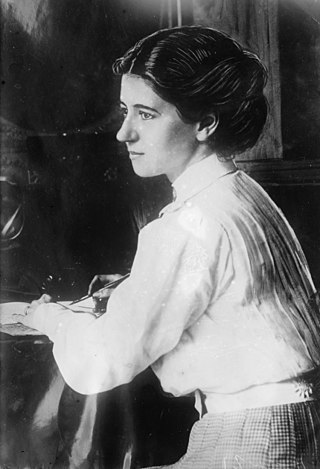
Violet Oakley was an American artist. She was the first American woman to receive a public mural commission. During the first quarter of the 20th century, she was renowned as a pathbreaker in mural decoration, a field that had been exclusively practiced by men. Oakley excelled at murals and stained glass designs that addressed themes from history and literature in Renaissance-revival styles.
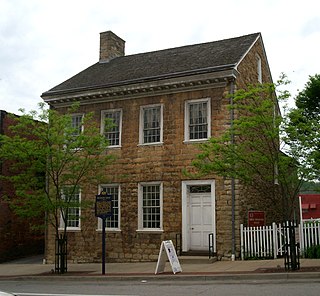
The David Bradford House is a historic house museum at 175 South Main Street in Washington, Pennsylvania. Completed in 1788, it was the home of David Bradford, a leader of the Whiskey Rebellion. It has both architectural and historic importance, and was designated a National Historic Landmark in 1983. It is open weekly between April and November, or by appointment.
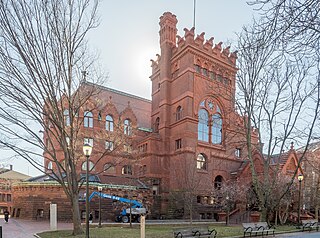
The Fisher Fine Arts Library was the primary library of the University of Pennsylvania in Philadelphia from 1891 to 1962. The red sandstone, brick-and-terra-cotta Venetian Gothic giant, part fortress and part cathedral, was designed by Philadelphia architect Frank Furness (1839–1912).

The Henry O. Tanner House is a historic house at 2908 West Diamond Street in Philadelphia, Pennsylvania, USA. It was from 1872 to 1888 the childhood home of Henry Ossawa Tanner (1859-1937), an African-American artist who was the first of his race to be elected to National Academy of Design. This rowhouse was designated a National Historic Landmark in 1976.

Moore College of Art & Design is a private art school in Philadelphia, Pennsylvania. It was founded in 1848 by Sarah Worthington Peter as the Philadelphia School of Design for Women, and was renamed the Moore College of Art & Design in 1989. Although the school's undergraduate programs were historically only open to women, Moore opened admission to transgender, nonbinary, and gender-nonconforming students in 2020. Its other educational programs, including graduate programs and youth programs, are co-educational.

St. Michael's Episcopal Church, Parish House and Rectory is a group of architecturally-significant religious buildings located at 200-216 North Mill Street in Birdsboro, Berks County, Pennsylvania. It was added to the U.S. National Register of Historic Places in 1982.

Willis Gaylord Hale was a late-19th century architect who worked primarily in Philadelphia, Pennsylvania. His flamboyant, highly-ornate style was popular in the 1880s and 1890s, but quickly fell out of fashion at the dawn of the 20th century.

The Forrest Block is a historic building located in downtown Davenport, Iowa, United States. It was individually listed on the National Register of Historic Places in 1983. In 2020 it was included as a contributing property in the Davenport Downtown Commercial Historic District.
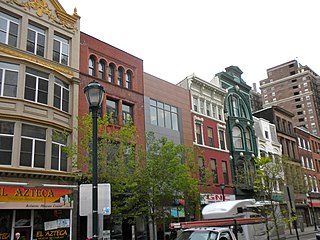
The East Center City Commercial Historic District is a national historic district located in the Washington Square neighborhood of Philadelphia, Pennsylvania. It encompasses 287 contributing structures, including large and small commercial buildings, banks, hotels, newspapers, clubs, and restaurants.

Edwin Forrest School is a public elementary school located in the Mayfair neighborhood of Philadelphia, Pennsylvania. It is within the School District of Philadelphia.

Charles Schaeffer School is a historic former school building located in the Germantown neighborhood of Philadelphia, Pennsylvania. The building was renovated in 2019 and is now the corporate offices of the Philly Office Retail real estate company.
New Freedom Theatre is an African-American theatre company in residence at the Freedom Theatre in Philadelphia established in 1966. The theatre has mounted several hundred productions as well as having taught tens of thousands of students in their 50-year-old educational programs history, making it Pennsylvania's oldest African-American theatrical institution.
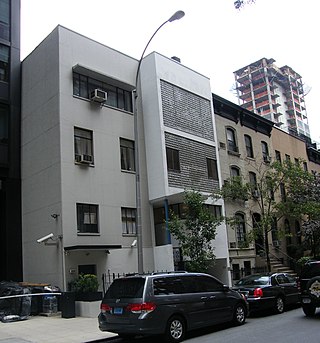
The Lescaze House is a four-story house at 211 East 48th Street in the East Midtown and Turtle Bay neighborhoods of Manhattan in New York City. It is along the northern sidewalk of 48th Street between Second Avenue and Third Avenue. The Lescaze House at 211 East 48th Street was designed by William Lescaze in the International Style between 1933 and 1934 as a renovation of a 19th-century brownstone townhouse. It is one of three houses in Manhattan designed by Lescaze.
























